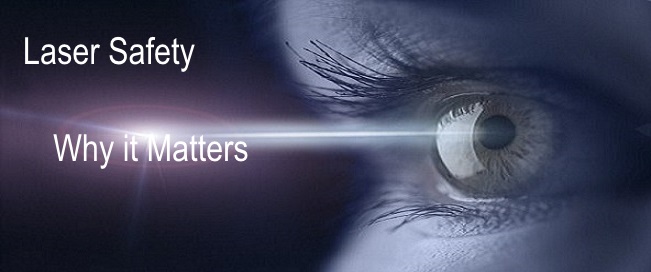
In this issue:

Incident Statistics Show Growing Need for Proper Training
While most people are aware of the dangers associated with misuse of laser-pointers, little is known about the extent to which lasers are found in every day work-environments. A worker may be exposed to lasers while scanning a bar code, performing a procedure in a medical or veterinary practice, monitoring a machine cutting through metals, ceramics, plastics, or multiple thicknesses of cloth, levelling a beam in a construction project, setting up an entertainment show or while conducting research. Of the reported laser accidents, 75% of personnel were accidentally exposed due to improper training and lack of controls. (www.rli.com)
Exposure to high-powered lasers may result in irreversible eye and skin damage, unless safety measures are in place. A good laser-safety program backed by solid training is key to protecting your staff from accidental exposures.
A designated laser safety officer (LSO) is mandated for any workplace that utilizes hazardous lasers. One significant role of the LSO is to be an educational resource. An LSO can recognize critical laser hazards and develop operating and control strategies to protect employees.
One of our Safety partners, KRMC Inc., provides a unique Laser Safety Officer Training course with a Canadian context to meet provincial and federal requirements using ANSI standards and the updated ANSI Z136.1 (2014) Safe Use of Lasers. The course provides detailed training on how to implement and administrate a laser safety program within your organization, as well as examples of hazard calculations that may be required by the LSO on a regular basis.
KRMC Inc.'s President, Liz Krivonosov says- "We believe in providing high quality Canadian content training for Laser Safety Officers. Our goal is to provide the LSO with information that is organized in a way that will be useful every day for safety administration. We've successfully trained personnel from both private organizations as well as provincial government bodies."
Another way to become educated is to attend laser safety conferences. The upcoming International Laser Safety Conference (ILSC) takes place this year in Albuquerque, New Mexico this March 23-26, 2015, covering all aspects of laser safety and hazard control.
Additional Resources:
A link to KRMC's course may be found at: KRMC LSO Training Course.Next scheduled training: Apr 07-09, 2015.
Details of ANSI Z136 standards may be found at: LIA ANSI Z136
ILSC Conference website: Laser Safety Conference
Lasers Used in Development of New Cancer-Detection Method
A group of researchers at the University of Cincinnati have developed a new, highly sensitive method to detect the presence of V600E- the most common mutation of the BRAF cell in humans. V600E accounts for a variety of cancers including melanoma, thyroid cancers and non-small cell lung cancer. The method is based on Luminescence Resonance Energy Transfer (LRET) between upconversion nanoparticles (UCNPs) and an intercalating dye. Laserglow Technologies' 980nm laser was used as an excitation source.
Researchers used 4 DNA strands- two probes, one of which was covalently attached to UCNPs, and 2 target DNA strands- one of which contained the V600E mutation while the other was normal (wild-type) DNA. They found that in the presence of mutated DNA and ligase1, the DNA strands joined together to form hairpin-like structures. However, no such phenomenon was observed when wild-type DNA were used.
Using this method, researchers were able to isolate the mutated DNA sequence from the normal (wild-type) DNA sequence with a mutant-to-wild-type ratio of 1:1000. The researchers feel that this detection method has potential for many clinical applications, and could be adapted to detect other mutations.
The research was published on 23 Oct 2014, and appeared in issue 99 of Royal Society of Chemistry's RSA Advances online journal. Find out more at: RSA Advances Full Article
1-Ligase - any of a class of enzymes that catalyze the formation of covalent bonds and are important in the synthesis and repair of biological molecules, such as DNA. (Collins English Dictionary - Complete & Unabridged 2012 Digital Edition)
Optogenetics: New method allows scientists to monitor and stimulate neurons at the same time
Optogenetics encompasses a range of techniques which enable control or monitoring of select populations of neurons. Until now, researchers were only able to use these techniques separately. Researchers at University College, London have recently developed a system that allows them to combine these techniques to observe and stimulate neurons simultaneously.
The basis of Optogenetics is the presence of certain light-sensitive proteins in neurons. Some proteins light up only when the neuron fires in response to some stimulus. This allows scientists to observe the natural behavior of those neurons. There are other proteins that cause a neuron to fire (i.e. behave in its natural way) when the neuron is stimulated with a pulse of light, thereby enabling scientists to trigger a reaction. However, this caused every neuron in the vicinity to trigger. This made it impossible for researchers to target individual neurons in a living brain, when they behaved in unexpected ways.
The new method overcomes these limitations and allows scientists to choose which specific neuron will be excited with pulsed light inside the living brain at any given moment. Find out more at: Scientific American Full Article